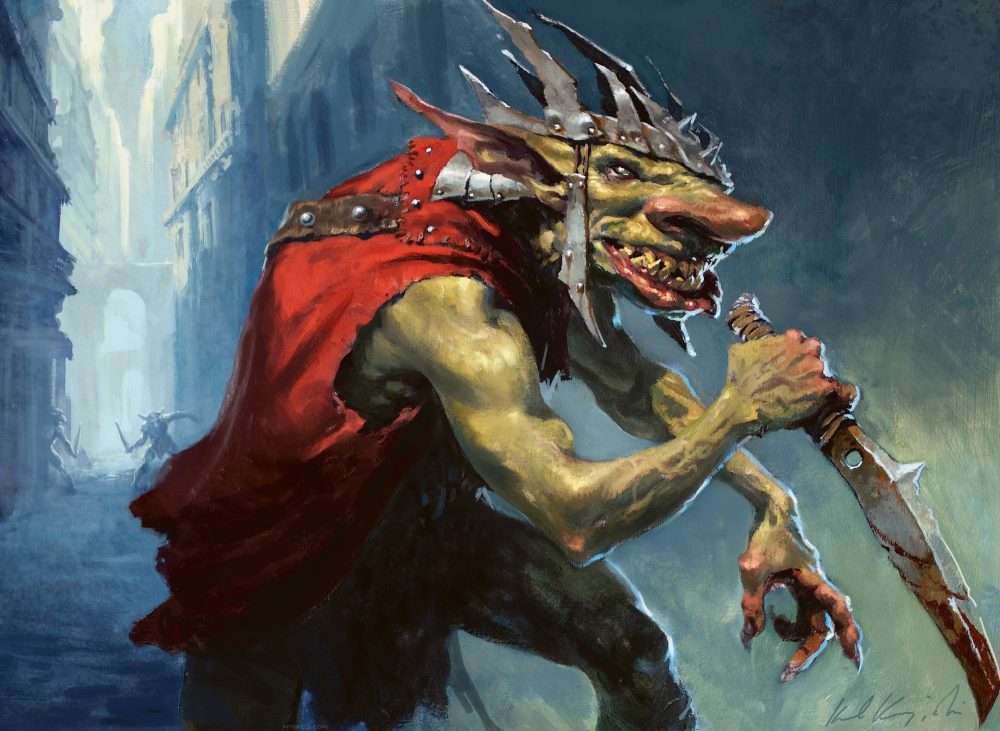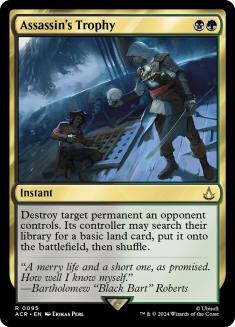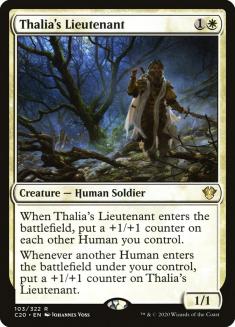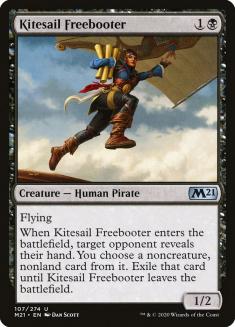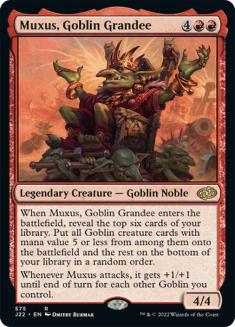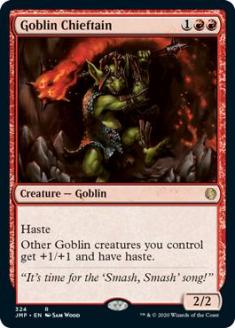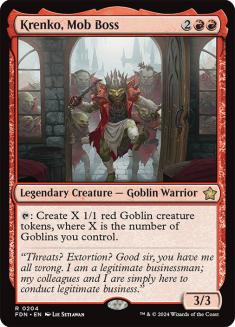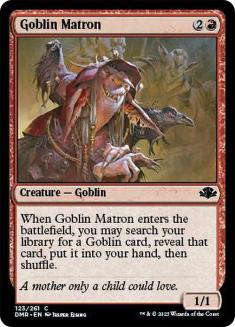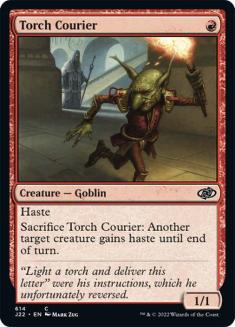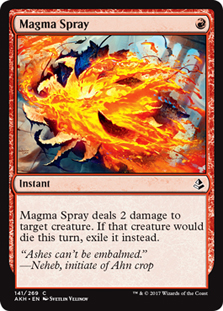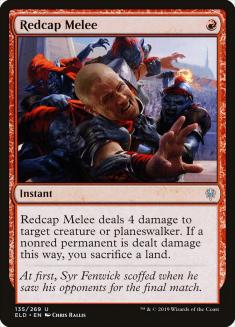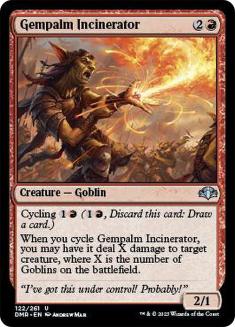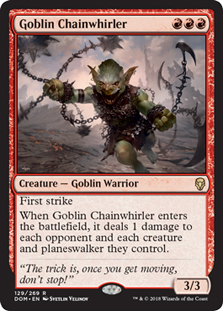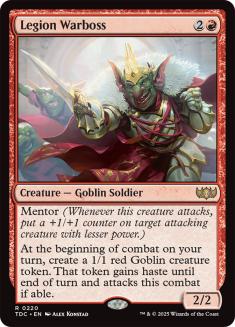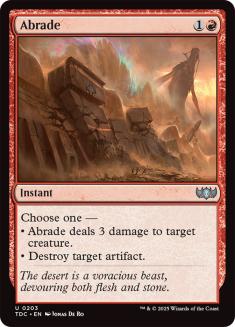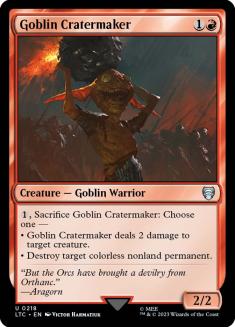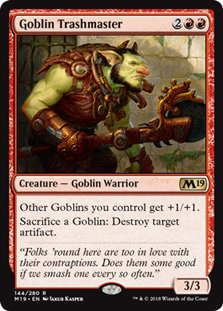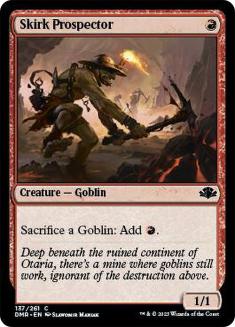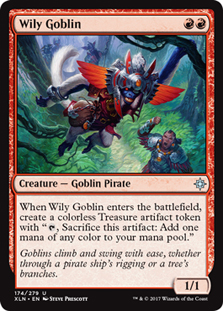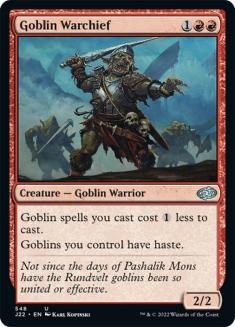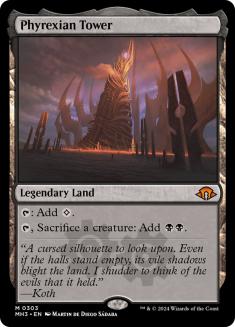Picture it: you, reading my article. You’re reading the opening, smirking at some clever bit about Goblins, the 9th-place bridesmaid finish, and the perfect segue into real strategy content. The bit is good enough that you’ll make it past the decklist and even read the strategic bits at the beginning of the article, so I give you the list up front:
Creatures (35)
- 4 Goblin Matron
- 4 Goblin Warchief
- 1 Gempalm Incinerator
- 1 Goblin Ringleader
- 4 Skirk Prospector
- 4 Goblin Chieftain
- 4 Krenko, Mob Boss
- 4 Wily Goblin
- 1 Torch Courier
- 4 Conspicuous Snoop
- 4 Muxus, Goblin Grandee
Lands (25)

It’d be great if I could write that well, huh?
All meta nonsense aside, last weekend was the Mythic Invitational, the first Pro-level event featuring the Magic Arena-exclusive Historic format. For the event I worked with Autumn Burchett, and throughout the event, I felt myself operating on a level ahead of most of my opponents. What was different between this event and other ones?
It was all in how Autumn and I framed our approach to matchups.
Leaning
The very first time that Autumn and I had a committed discussion about Goblins I brought up the fact that the way I was thinking about the deck while piloting was similar to midrange: there are “good halves” and “bad halves” of your deck in any given matchup. This piggybacks from the mentality that midrange decks generally have cards in their deck that spread them a bit thin throughout their possible matchups, with draws that range from unbeatable to embarrassing.
Take Jund Midrange in Modern for example. Cards like Thoughtseize and Assassin’s Trophy look amazing on paper, but quickly become embarrassing against Goblin Guide and friends. Similar still is the Modern Humans deck and its approach to the game:
Thalia’s Lieutenant and Kitesail Freebooter are both in the maindeck of Humans, but they aren’t going to be at their best in the same matchups. After all, Thalia’s Lieutenant is better for playing to the battlefield, and Kitesail Freebooter is better at disrupting cards that haven’t quite made it there yet. The roles of Goblins’s cards aren’t as overt in their functionality, but the theory is similar.
For a majority of our matchups, Autumn and I simply talked about if we were leaning into being a deck based around Muxus, Goblin Grandee; Goblin Chieftain; or Krenko, Mob Boss. Why is this relevant? The cards have different asks, and demand different sequencing.
Muxus, for example, requires six mana sources in order to become involved in a game. In matchups where Goblins is adopting a controlling role, that isn’t always feasible, both because it’s dead in the early-game and because many of these games are going to force Goblins to player a lower-resource game to bridge for other cards to take over. This means that Muxus isn’t always the star of the show, despite most of the talk around Goblins being centered around the Grandee.
All of this will make more sense when we get to the matchup guide portion of the article, but the framing itself is useful and something that doesn’t just work for Goblins.
The 75
Most of the maindeck is fairly standard: 25 lands including a smattering of Castle Embereth and Phyrexian Tower, playsets of the eight best Goblins that make the deck go, and some Matron bullets.
I’ve seen a handful of lists that are shaving on copies of Goblin Matron, and I’m here to tell you that you do not do this. Goblin Matron basically is a companion rule for your Muxus (three mana and you get to add it to your hand). Except it does even more than that in some matchups, which makes her an easy four-of.
Okay, so this card is way less Raging Goblin than it looks. What Torch Courier actually does for this deck is that it’s a tutorable Crimson Wisps for a deck that’s desperate enough for haste that it plays the full eight possible three-drop haste-lords. This was pretty firmly the 60th card in the list, but before it was Torch Courier it was Goblin Instigator. The logic here is that it’s a card you’re almost always disappointed to draw, but there are a nonzero number of games where Muxus hits a Wily Goblin and a Goblin Matron, and Torch Courier is the way to give Muxus or Krenko haste from there.
It ain’t pretty, but sometimes you just gotta make do.
The sideboard is where things get a bit hairier, with some obvious posturing against what we expected to play against in the Mythic Invitational.
Single-mana interaction is at a premium in this deck for a couple of reasons. The easy and fundamental reason is that Goblins is an incredibly mana-hungry deck, and having removal that can fill out a curve is wonderful. The more card-specific reason is that one-mana removal plays splendidly with Wily Goblin.
Magma Spray over Redcap Melee was largely a consideration for Woe Strider, Dreadhorde Butcher, Cauldron Familiar, and Priest of Forgotten Gods. The matchup where Redcap Melee is at its best is in the mirror, where Autumn and I were leaning into a different removal spell:
Containing Muxus isn’t realistic, but having “draw a card” stapled onto Terminate was an attractive enough answer to Krenko and Goblin Chieftain that Gempalm Incinerator was maxed out.
Goblin Chainwhirler was one of the cards that we waffled the most on – which is to say it was hard to figure out if we wanted one, two, or three copies. We ended up going for the single Matron-able copy, largely because we didn’t expect the matchups it’s great in to come up a ton. I don’t regret having the single copy, but would likely change one of the Gempalm Incinerators to a Goblin Chainwhirler moving forward.
The week leading up to the Mythic Invitational had a bunch of Teferi, Hero of Dominarias fueling Wrath of Gods, and Legion Warboss is one of the best cards in the matchup. We wanted four cards to bring in against Azorius-based decks, and these fit the bill.
Having a reliable answer to Mayhem Devil and Dreadhorde Arcanist is crucial. Abrade also has the luxury of being able to tag both Grafdigger’s Cage and God-Pharaoh’s Gift in the matchups where players have creatures and targets for a Shatter.
One of the smarter things that we did for the event was have a split between Goblin Cratermaker and Goblin Trashmaster. Cratermaker does a reasonable Abrade impression in a ton of spots, while also being tutorable via Matron. This was relevant against a Sultai opponent who had Grafdigger’s Cage and Kaervek, the Spiteful in their 75.
Goblin Trashmaster has a healthy amount of points in its corner by virtue of simply being another lord and not requiring any additional mana investment to hold up an instant-speed Shatter at all times.
All right gang, gather ’round.

Unfortunately, it hasn’t been 2003 in a long, long time, and it’s time to stop treating Goblin Ringleader like it leads the ring in 2020.
Magic today isn’t a game where players actually run out of cards. Between Conspicuous Snoop, Goblin Matron, and Muxus, it’s rare that the problem is “I ran out of stuff to do.” Without Aether Vial to give the deck a glut of mana to use, Goblin Ringleader is mostly a sideboard card for the drawn out control decks that don’t have a ton of inevitability.
The card is exactly fine, and it’s about damn time people figured out why successful Goblins lists are playing between zero and two total.
Matchups
All right you vultures, here’s the sideboard guide:
VS Goblins (The Mirror)
Out:
In:
The real secret to the mirror is that the matchup is actually a Krenko, Mob Boss matchup. That’s to say all the game actions taken in a game can generally be invalidated by the player that gets to activate Krenko more times than the opponent.
These are how Krenko matchups are going to be defined. Will a pile of 1/1s be largely insurmountable by the opponent? If so, simply forcing Krenko activations is the name of the game. These matchups are the ones where Muxus really shines, not as a Gigantosaurus with friends, but as the world’s most powerful Collected Company. More specifically, a Collected Company that can generate a Krenko, a form of haste, and enough bodies for Krenko’s activation to put the game away.
This matchup actually introduces a lot of common trends in sideboarding with the deck that are worth going over.
Skirk Prospector gets trimmed a good amount in sideboard games, because the games are slower. This places a higher emphasis on grinding, and the opponent is going to be better at interacting with the deck’s fast draws. That means that Blood Pets are going to be less valuable and stumbling over multiple copies can be a death sentence.
By the same token, Goblin Warchief loses a good bit a stock in matchups where removal becomes prevalent. This is because it does almost nothing unless you cast another spell in the same turn, or you get to untap with it. Having a density of haste lords in the deck is necessary for maximizing the efficacy of Muxus, but actually sticking a Goblin Warchief when players are slinging removal spells is a tall order. Trading a Warchief for a Magma Spray is vomit-inducing, and the gut-wrenching feeling of that exchange doesn’t really shift based on what other cards your opponent has paired with their removal.
With Gempalm Incinerators being such a big part of the plan, committing so much mana at sorcery speed to simply develop a 2/2 on the battlefield and draw a few cards isn’t a particularly attractive option.
In the matchups where being combo-oriented and fast is the only thing that matters (like Ramp strategies) Torch Courier is fine. Outside of that, it’s a bit underwhelming and fairly easy to move to the sideboard for many of the same reasons that Skirk Prospector gets trimmed in matchups. If the game isn’t about speed and combo turns aren’t as reliable, you don’t want to ever run the risk of burning a draw step on a Raging Goblin.
Wily Goblin and Goblin Matron are two of the easier cards to trim on because one is fairly low on power level, and the other simply provides redundancy. Both of these become less valuable in games that go longer, because taking draw steps will give a natural form of redundancy by virtue of simply seeing a larger sample of one’s deck. These two cards in particular being embarrassing against Goblin Chainwhirler is a another strike against drawing too many copies against players with the Chainwhirler.
This matchup will depend a bit on what the opponent’s sideboard looks like. If they have zero copies of Goblin Chainwhirler, I’d cut a third Goblin Warchief and leave one of the Skirk Prospectors in the deck.
VS Bant Control
Out:
In:
If they have Grafdigger’s Cage, also…
Out:
In:
This matchup is pretty good, because most Bant decks don’t actually have a way to pressure Goblins back. This means that you can simply cast a Goblin that demands a sweeper by itself such as Legion Warboss or Conspicuous Snoop, wait for them to spend a Wrath on it, and then cast one or two more cards that demand a sweeper on their own, and so on. These exchanges generally end up hurting the opponent’s life total each time and put them in range of a Goblin Chieftain and a couple of friends sealing the deal.
Gempalm Incinerator gets a little bit better as a one- or two-of if they have a bunch of relevant targets, but it’s hard to have enough Goblins on the battlefield to cycle down an Elder Gargaroth.
VS Sultai Midrange
Out:
In:
If the opponent has Grafdigger’s Cage or Kaervek, the Spiteful, Goblin Cratermaker is better than a Legion Warboss.
The big shift in how to play this matchup comes down to how Nissa, Who Shakes the World influences the game. She actually allows Sultai Midrange to keep pace and close the door if Goblins doesn’t end the game quickly enough. This forces Goblins to try to be a bit more combo-oriented.
Goblin Trashmaster can provide a bit of insulation against Cry of the Carnarium, but largely just makes it easier to attack into Nissa, Who Shakes the World.
VS Azorius Auras (Lurrus)
Out:
In:
This is the matchup where Goblins leans the hardest into being a Krenko deck. Between Hushbringer, Grafdigger’s Cage, Containment Priest, and more, the Azorius Auras decks around the ‘net have a ton of ways to check Muxus. So rather than always trying to force it, it’s better to simply opt out of the fight, let the opponent commit a ton of cards to fighting a battle that isn’t coming, and try to go around it.
Worth noting: Skirk Prospector sacrificing creatures mid-combat is a great way to shut off the opponent’s source of lifelink and actually race whatever giant knucklehead they’ve built.
VS Mono-Red Burn
Out:
In:
(If they’re high on Goblin Chainwhirler, cut another Wily Goblin for another Gempalm Incinerator.)
This matchup has the Burn deck frequently trading with creatures on Goblins’s side, trying to contain Muxus. Playing into that gameplan and shaving creatures that trade unfavorably for removal spells is a good way to force the opponent to play a losing game.
Burn decks frequently have Grafdigger’s Cage for Goblins, which also shuts off their best grinding tool in Experimental Frenzy.
VS Jund Sacrifice
Out:
In:
This matchup largely comes down to checking Mayhem Devil and embarrassing the Woe Strider half of their deck. Trim cards that Mayhem Devil completely devours (read: X/1 creatures) and add cards that compensate for it. Magma Spray is a nice check for Priest of Forgotten Gods and Dreadhorde Butcher and the cards it’s replacing are underwhelming.
Something worth noting on Arena is the importance of setting stops against decks with Claim the Firstborn, or any other effect where you may want to sacrifice a creature in response to their spell, when Arena might not give you priority.
Set stops during your opponent’s main phases, and get really comfortable with the space bar. That way you’ll get a chance to sacrifice a Skirk Prospector before they steal it, or you can sacrifice a creature to Phyrexian Tower without anything else to do but deny your opponent the attack.
I promise it’s a skill worth developing, and it won me multiple games last weekend.
VS Rakdos Pyromancer (Lurrus)
Out:
In:
Dreadhorde Arcanist is the scariest card here, because it serves as a repeatable source of removal. The same goes for Priest of Forgotten Gods if they have access to it. The deck can’t usually beat untapping with a Krenko, and prioritizing Krenko activations is a good baseline approach to the matchup. That’s not even getting into the fact that the Shock / Claim the Firstborn / Eliminate / Innocent Blood deck has trouble answering Krenko himself.
VS Mono-Blue Aggro
Out:
In:
Become a Goblin Chieftain deck. Lean into being a low-to-the-ground aggro deck with a reasonable disruption package. Muxus might come up with Goblin Matron, but overall is an afterthought.
VS Simic Ramp
Out:
In:
Swapping out bullets for better bullets. Cosmetic changes. Let me just take the words directly out of the matchup guide Autumn and I made:
Uh-TACK!*
(*Pronounced aTTACK!)
VS Mono-Black God-Pharaoh’s Gift
Out:
In:
This is another one of those matchups where having priority during the opponent’s main phase can be a big deal — it’s literally the difference between life and death against Massacre Wurm a majority of the time.
Goblin Trashmaster being a lord ends up being very relevant in this matchup because having two lords on the battlefield shuts off Massacre Wurm from killing anything the turn it enters the battlefield. Simply having one lord on the battlefield also forces the opponent to have a creature to kill with Massacre Girl for her ability to actually kill anything as well.
Ultimately, this matchup is about comboing, because given enough time they’ll go over the top of Goblins, and they lack the same explosiveness. Check Priest of Forgotten Gods and don’t leave yourself dead to Massacre Wurm and you’ll likely be fine.
VS Gruul Aggro
Out:
In:
This is a matchup where Goblins are firmly the control side of things. Check Embercleave and you’ll likely be able to go over the top of whatever they do. If they have Zhur-Taa Goblin, Gempalm Incinerator number four becomes a bit more attractive, as it counts Goblins on both sides of the battlefield.
This is a matchup where the way that lords can affect sizing comes up a good bit, and makes this feel like another matchup that’s defined by Goblin Chieftain, rather than anything else.
Practice
At the end of the day, reading when you need to lean into a different part of the deck is going to take a great deal of practice, and the hard games are much harder than the easy games are easy. I put roughly 150 total hours into this Invitational and a good chunk of that was with Goblins.
It’s incredibly rewarding to learn the ins and outs of such a powerful deck, but it isn’t free. I recommend getting started sooner, rather than later. Who knows how long this thing will be legal?

